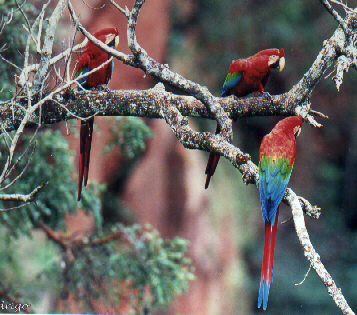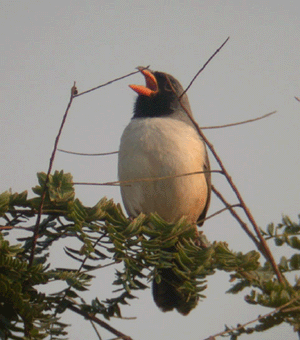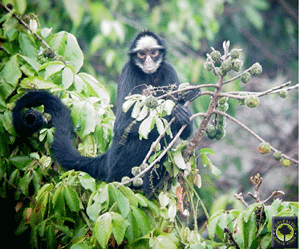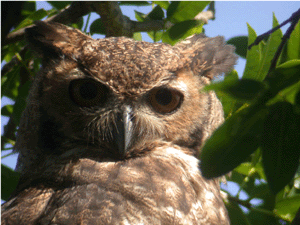

The Wildlife and Wildlands
of Brazil - June 2005
In June of 2005 I will lead a 10-day nature tour to Brazil. This will be a truncated version of the 2003 trip (Read the collected journal from the '03 trip). We will sample a wide diversity of habitats, including the dry savanna around the Chapada dos Guimaraes escarpment (see the first picture below), the rainforests near Alta Floresta, and the incredible, vast wetlands of the Pantanal.
Ground costs (excluding travel to Brazil) are being calculated at the moment. First guess in that it'll be around $2300-2800 per person, which includes a $300 contribution to one of the non-profit conservation groups with which I work (Carolina Raptor Center, Catawba Lands Conservancy, or Audubon-North Carolina).
Our ground agent is Birding Brazil Tours, recently featured in the Sunday New York Times travel section. Birding Brazil is run by Andy Whittaker, who came to Brazil in the early 80s to band birds for me in the Amazonian rainforest and fell so in love with the country that he stayed on and now makes his living leading tours around South America.
Our Itinerary:
Sat
June 4:
Leave US on flight to Sao Paulo
Sun June 5: On arrival to Cuiaba on VARIG/TAM RG JJ 3804 09:00-11:10 you will be met by Braulio our excellent English speaking birding guide and your comfortable air-conditioned van transportation. You will then transfer to the best Churrascaria (Brazilian barbecue) in town. Here the wonderful food and friendly Brazilian atmosphere offer a perfect start to your trip. After a superb lunch we will drive 65 km of paved road to Chapada National Park.
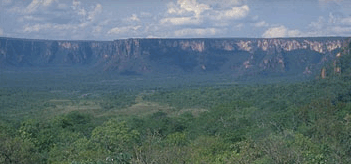 |
The canyon lands of the “Chapada dos Guimaraes” form part of the Brazilian Planalto Central. These magnificent red sandstone formations are reminiscent of the northeastern Arizona landscape. The Chapada National Park protects specialised rich cerrado vegetation along with its unique fauna and flora. As we ascend the plateau we will wind through strange interesting rock formations and patches of rich cerrado and gallery forest. |
|
A spectacular view greets us as we arrive at our Pousada Penhasco (see more about this hotel) home for this night. Each room has p |
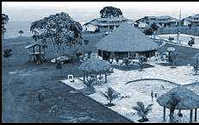
|
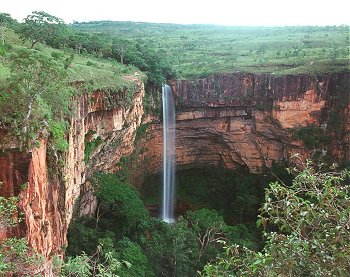
|
After checking in we drive just a short
distance to a spectacular sandstone canyon where a magnificent 80m waterfall
(named not so originally, Bridal Veil Falls) plunges into a lovely wooded
gallery forest below. Here we expect to have a great spectacle as roosting
parrots arrive, including the rare endangered Blue-winged Macaw, Red-and-Green
Macaw, White-eyed Parakeets and Blue-headed Parrots. On occasions great
spiraling flocks of both Buiscutate and Great Dusky Swifts whirl into roost
behind the waterfalls. Night and dinner at our Pousada. |
|
|
Green-winged Macaws near the Bridal Veil Falls. |
| Mon June 6: Awakening to the cooler climate we will explore the fascinating cerrado and its abundant and fascinating different avifauna. The haunting calls of Red-legged Seriema (bizarre looking more like an African Secretary bird!) and Red-winged Tinamou fill the fresh morning air. Specialities include Aplomado Falcon, Burrowing Owl, both White-rumped and White-banded Tanager, Curl-crested Jay the newly described Chapada Flycatcher, Horned Sungem, White-vented Violetear, White-eared Puffbird, Checkered Woodpecker, Collard Cresentchest, Blue and Coal-crested Finch, Rufous-winged Antshrike, Black-throated Saltator, (pictured at right), Swallow Tananger, Plumbeous Seedeater and possibly the rare Rufous-side Pygmy Tyrant. |
|
| Transfer to Cuiaba to catch Alta Floresta connection 11:59- 14:05. As our plane approaches Alta Floresta you will suddenly notice the abrupt change in vegetation going from the cerrado scrub to lush tall green Amazonian rainforest. Upon arrival we will transfer in our van birding on our way to the lovely Cristalino Camp situated on the banks of the wonderful Rio Cristalino. This involves a 1.5 h drive and a 30 min boat trip across the Teles Pires River and up the Cristalino River. |
|
| The confluence of the black water of the Cristalino with the yellow-brown water of the Teles Pires creates a fascinating phenomenon. The experience of boating up the untouched beautiful Cristalino River is a delightful experience. The Cristalino camp (at right) has charming fully screened chalets with private bathrooms fans and the lodge has incredibly good food. |  |
|
|
This area is one of the richest areas of the Brazilian Amazonian with pristine rainforest at ones doorsteps, with Macaws, Parrots and Toucans often constantly around the chalets. No hunting allows wonderful chances to see large game birds and many primates including White-bellied Spider Monkeys, White-nosed Saki Monkey (with red noses!) and Brown Capuchin Monkey can often be found in the immediate area. |
Tues-
Thur June 7-9:
There is no other better way to experience the Amazon rainforest it’s smells,
its sounds and its fantastic fauna and flora than here in this truly amazing
paradise! Therefore we have 3 full days to carefully explore this incredibly
rich site for its staggering 520+ bird species. The Cristalino camp holds it
all, miles of clean well -marked forest trails through pristine rainforest,
abundant bamboo along with a new 45m canopy tower to experience the fantastic
canopy birds. Afternoon boat trips offer great birding and due to black water
(no mosquitoes!) with great chance for mammal observations with many primates,
Red and Gray Brocket Deer, Brazilian Tapir, two Otter species and even the
chance of the king the Jaguar or a Puma! Wonderful trails located upriver from
the lodge can be reached by boat that lead to a spectacular hill overlook and
another in an area full of the immense Brazil nut trees. Behind the lodge the
tapir lick hide gives you an opportunity to quietly wait for this huge poorly
known animal or possibly a large group of White-lipped or a family party of
Collard Peccaries coming in to eat the natural salts.
| For
sure your tower trips will be another great highlight, as dawn breaks around you
in the canopy Parrots start to stir and fly close screeching noisily past.
Possibilities include the recently described poorly-known Kawall’s,
White-bellied, Red-fan (pictured at right), Mealy and Yellow-crowned Parrots or Painted Parakeets.
White-throated and Yellow-ridged Toucan, while Gould’s Toucanets perform their
“see-saw” antics singing on top dead snags, meanwhile
brilliant colored canopy flocks start move by at eye level. These include
spectacular colorful Honeycreepers, Paradise Jacamar, Paradise, Opal-rumped,
Yellow-backed and Red-billed Pied tanagers or even the rarely seen
Yellow-shouldered grosbeak and Tooth-billed Wren. High above this vivid green
carpet we are in a great spot to see the big raptors where both Harpy and
Crested Eagle are possible! A late afternoon return visit to watch the forest go
to sleep and observe a truly spectacular Amazonian sunset is something you
should not miss! |
 |
Relaxing
in camp will be equally inviting, especially with bar service on the floating
dock sipping your Brazilian national drink a refreshing Caiparinha (limes with
rum and ice). Swimming and swinging of ropes like Tarzan or Jane into the
crystal clear Cristalino River is a must!
See a photo taken not too long ago by someone visiting the lodge!).
Friday
10 June:
We’ll have our final morning in this beautiful forest around Cristalino and
transfer bird our way back to the very pleasant Hotel Floresta Amazonica in Alta
Floresta where we will have lunch. We may be lucky to see point-tailed
Palmcreeper or Red-bellied Macaws on route. After a great lunch we will catch
our trip 14:20-16:30 flight back to Cuiaba.
Next
stop: The Pantanal
| On arrival we will drive to Pocone and enter the famous Transpantaneiro dirt road and commence our adventure! Birding en route as we enter into the vast Pantanal will introduce us to this “World class” waterbird stronghold, highlights will include the massive 747 of the bird world, namely the stately Jabiru Stork. Shrinking pools are alive with life including Wood and Maguari Storks, White-necked, Whistling and Capped Herons, Roseate Spoonbill, Plumbeous, Bare-faced, Green and Buff-necked Ibis, Southern Screamer, Sunbittern and Gray-necked Woodrail. Snail Kites, so endangered in Florida, is perhaps the most common member of the raptor family and seen feeding on either Apple Snails or a fresh water crab. Other common raptors include Great Black, Crane, Black-collared and Savannah Hawks. | 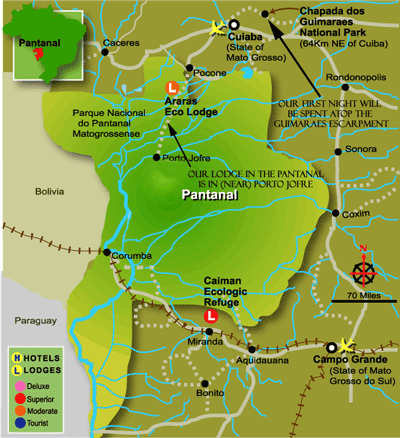 |
| The Pantanal is also home to one the most spectacular members of the parrot family, the endangered Hyacinth Macaw and one of our many big targets. Banks are lined with staggering numbers of Yellow Caiman along with herds of the world’s largest rodent the Capybara grazing the grasslands. Possibilities also include one of the worlds largest snakes the spectacular Yellow Anaconda which often is observed crossing or sunning itself on the road! We will arrive after dusk at our lovely family run Pousada nestled alongside the wonderfully rich picturesque Pixiam River. | 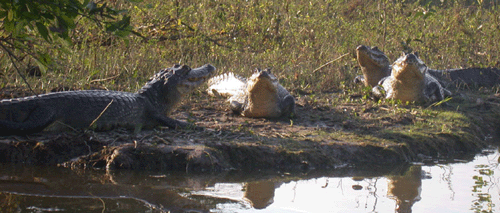
|
Full board for three nights where the lodge offers rooms with
private bathrooms and air conditioning and great home cooking!
Sat
11- June: A
tremendous dawn chorus comprising of a cacophony of Limpkin, Chaco Chachalaca,
Plumbeous Ibis, Paraque and flocks of noisy Turquoise-fronted Parrots greets us
as dawn breaks. Today we will explore this amazingly rich area by foot and also
along the road. The nearby river and galley forest are alive with life and
regularly we can chalk up from 150-180 different bird species in a single day!
The gallery forest hold such gems as Helmeted Manakin, Pale-crested Woodpecker,
Rusty-backed Spinetail, Band-tailed and Mato Grosso Antbird, Large-billed
Antwren, Flavescent Warbler, Masked Gnatcatcher, Buff-bellied Hermit,
Stripe-necked tody Tyrant, Ashy-headed Greenlet, Plain Tyrannulet, Fawn-breasted
wren, Orange-backed Oriole and Gray-crested Cachalote. While around the lodge
the amazing Toco Toucan, Great Rhea, Whistling Heron, Yellow-billed and
Red-crested Cardinal, Saffron Finch, Bay-winged Cowbird, Purplish Jay and
Kingfishers abound fishing along the Pixiam River. After a good lunch we can
take a siesta or a dip in the pousada’s pool. Later in the afternoon as the
temperature starts to drops we will take a fantastic boat trip along the rich
Pixiam River. Here all five Kingfisher are possible, Rufescent Tiger heron,
Egrets, Sungrebe and Sunbittern and often the strange frog eating Boat-billed
Heron. We will search for the endangered Chestnut-bellied Guan, Black-hooded
Parakeet and even the rare Agami Heron in all its splendours is possible!
Mammals abound and here the unique rare opportunity of a close encounter with
the resident families of Giant River Otters is a true highlight. Both Black
Howler and black-capped Capuchin Monkey are regularly seen along the forested
riverbanks. As night sets in both Band-tailed and Nacunda Nighthawks grace the
air as they leave their daytime roosts to hunt insects. We will have dinner and
night at the lodge.
| Sun 12 June: Today after a hearty breakfast we will explore further into the Pantanal, birding our way to our encounter with the World’s largest and most spectacular Parrot, the Hyacinth Macaw. En route we will be looking for Bare-faced Curassow, Southern Lapwing, Wattled Jacana, Large-billed Tern, Muskovey Duck, Brazilian Teal, Campo Flicker, Golden-green and Little Woodpecker, Rufous-tailed Jacamar, Yellow-chevroned and Peach-fronted Parakeet, Narrow-billed Woodcreeper, Great Antshrike, Rust-backed Antwren, Long-tailed Ground Dove, Thrush-like Wren and the exotic Chotoy Spinetail. Mammal possibilities include Silvery Marmosets, Collard Anteater and the endangered Marsh or Pampus Deer. Our main target a healthy wild population of the magnificent Hyacinth Macaws which are resident and breeding around the lodge. | 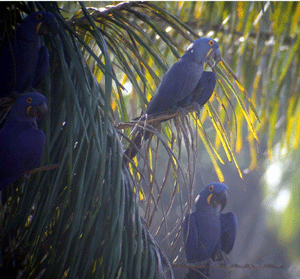 |
This allows us a unique opportunity to enjoy these truly
magnificent creatures in their full glory close up! This afternoon we may push
deeper into the Pantanal to explore some interesting large grassland’s and
marshes. We will drive back to our lovely lodge spotlighting this may well be a
highlight and our best chance to look for the rarely seen king of the food chain
the magnificent Jaguar! Other possibilities include Ocelot, Crab-eating Racoon,
Crab-eating Fox or even a huge Brazilian Tapir are possible. Night birds here
include Gray or Common Potoo, Paraque, Little, Spot-tailed and Scissor-tailed
Nightjar. Night and dinner Santa Teresa
|
|
Mon
13 June:
Exploration early today of the gallery forest may produce Blue-throated Piping
Guans, Golden-collard Macaws, Scaly-headed Parrots, Bare-faced Curassow,
Undulated Tinamou, Collard-forest Falcon, Bat Falcon, Guira Cuckoo, White and
Green-barred Woodpecker, Great-rufous Woodcreeper, Red-billed Sythebill,
Blue-crowned Trogon, Black-fronted Nunbird, White-lored Spinetail, Rufous
Casiornis, Guira, Hooded and Gray-headed Tanager, Chestnut-vented Conebill and
many more. After an early lunch we will have to say goodbye to this paradise and
transfer out of the Pantanal on route to Cuiaba for our afternoon connections to
São Paulo on VARIG departing 16:30 arriving São Paulo 21:00 to connect with
our homebound flights to US. |
![]()
[back to Eco-tours page] - [The 2003 Journal] - [Home page]
